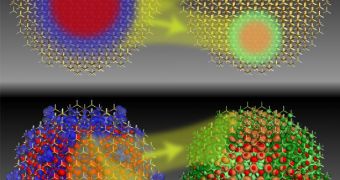According to the conclusions of a new scientific investigation, it would appear that the efficiency of existing solar cells could be significantly improved by shrinking the size of light-absorbing particles called quantum dots (QD).
The size of these particles is directly related to its ability to transfer energy from photons – the elementary particles making up light – to electrons, which form electrical current.
Scientists with the Colorado School of Mines (CSM) led by expert Mark Lusk, published details of their new discovery in a paper that will appear in the April issue of the esteemed journal ACS Nano.
The paper provides additional evidence to support a growingly-popular theory, called multiple-exciton generation (MEG). The idea is highly controversial at this point, but evidence is beginning to pile up suggesting it might be true.
What it basically states is that an electron that has absorbed the energy of a photon (and is now known as an exciton), can transfer that energy not to one, but many other electrons, therefore producing more electricity from the same amount of light.
Physicists constructing solar cells and panels want to develop the technologies they use to a point where they can control every aspect of the interaction between light and matter. The creation of artificial atoms called quantum dots is the first step in this direction.
What QD do is basically confine electrons in a very tight space. The structures have interesting, atomic-like behaviors, which gives birth to a host of unusual properties when these systems are analyzed at the nanoscale.
In the new investigation, the CSM group basically investigated the correlation between MEG rates and quantum dot sizes. The experts used a US National Science Foundation (NSF)-supported high performance computer cluster for the job.
“We can now design nanostructured materials that generate more than one exciton from a single photon of light, putting to good use a large portion of the energy that would otherwise just heat up a solar cell,” the team leader explains.
In the investigations, each QD was discovered to have its own slice of the solar spectrum in which it performed better, and carried out MEG more efficiently. In general, smaller quantum dots exhibited higher MEG rates.
“These results are exciting because they go far towards resolving a long-standing debate within the field,” explains NSF Division of Materials Research program director Mary Galvin.
“Equally important, they will contribute to establishment of new design techniques that can be used to make more efficient solar cells,” she concludes.

 14 DAY TRIAL //
14 DAY TRIAL //